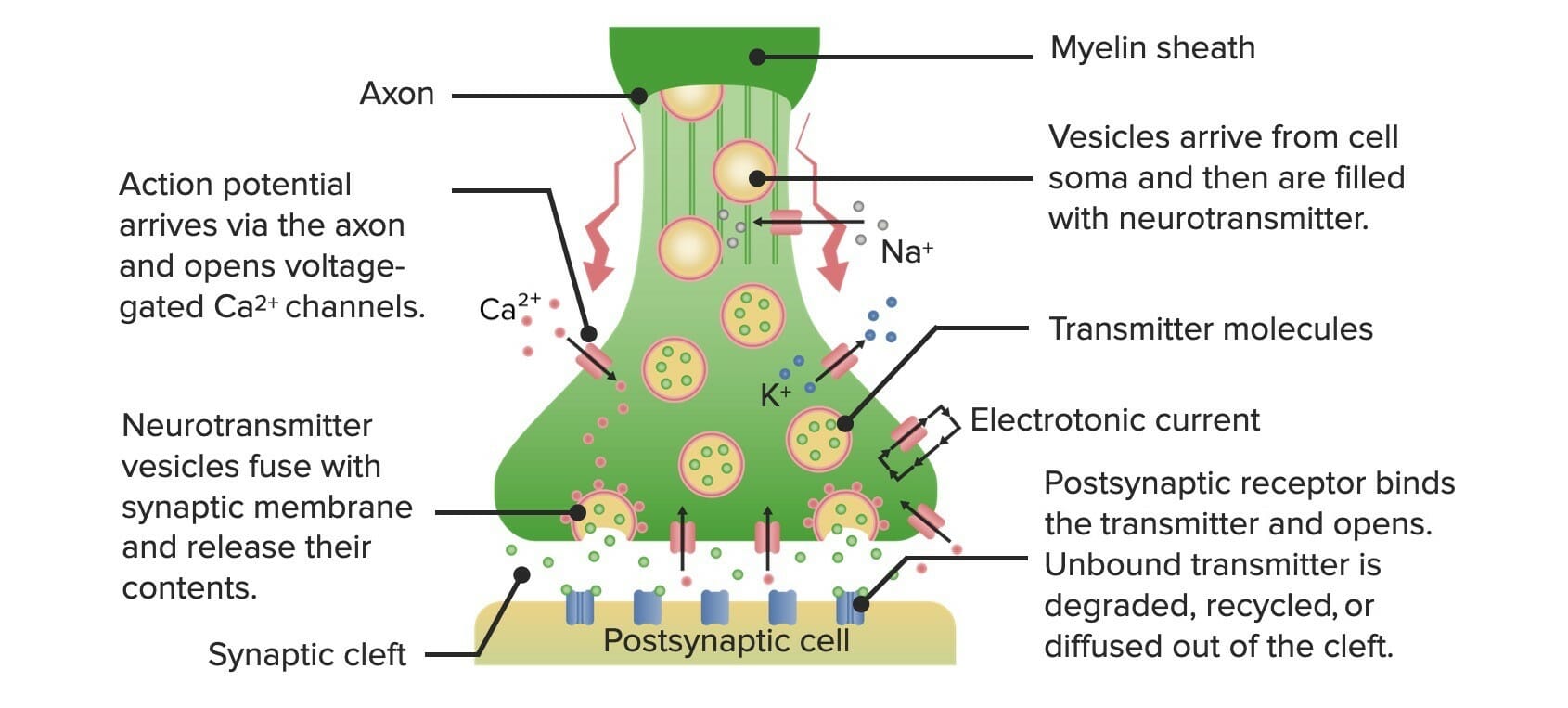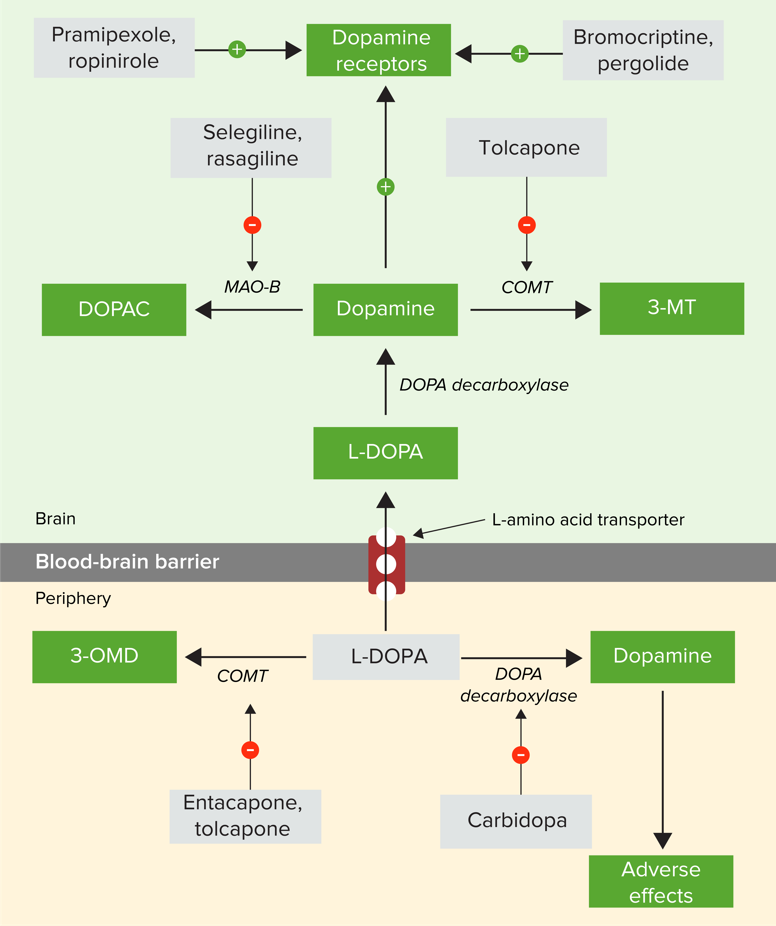Playlist
Show Playlist
Hide Playlist
Dopamine Precursors and Agonists – Treatment of Movement Disorders
-
Slides Dopamine Precursors Agonists Treatment of Movement Disorders.pdf
-
Reference List Pharmacology.pdf
-
Download Lecture Overview
00:01 Let's start with the drug levodopa. Why do we call it levodopa? Well, dopamine doesn't cross the blood brain barrier unfortunately. 00:10 So we have to use the L-enantiomer of dopa, L-DOPA, or levodopa. L-DOPA enters the brain via L-amino acid transporters. 00:23 So they are very specific transporters that actually actively move L-DOPA from outside the cell or outside the brain into the brain area. Toxicity of levodopa include anorexia, nausea and emesis. That just make sense because it's affecting the chemoreceptor trigger zone. Other symptoms include postural hypotension and tachycardia. And remember, that levodopa is contraindicated in patients who have psychosis because you are going to worsen the psychotic symptoms. What is carbidopa and why do we give it with levodopa? Well let's take a look at this reaction and interaction between drug and barrier. 01:05 L-DOPA is broken down by tissue decarboxylases in the peripheral tissues. This causes side effects. So when you have breakdown of L-DOPA into dopamine, it causes side effects in the peripheral tissue. Carbidopa blocks DOPA decarboxylase. You get prolonged activity of action and more transmission and movement of L-DOPA into the brain. You also have fewer side effects peripherally. 01:34 That's why we give carbidopa in association with levodopa. Let's talk about dopamine agonist, bromocriptine and pramipexole. 01:46 Bromocriptine and other analogues are ergot alkaloids. They are partial D2 agonist, and they increase the activity of dopamine pathways. 01:58 They may be used in combination with L-DOPA. The side effects of drugs like bromocriptine include nausea and vomiting through the CTZ, dyskinesia and confusion, and postural hypotension which I had mentioned before with L-DOPA. 02:14 The ergot alkaloid related side effects that are specific to bromocriptine are pulmonary infiltrates and erythromelalgia. 02:21 Erythromelalgia is a very unique kind of a skin reaction and you can see a women and her daughter. You can see the woman's hand is very swollen, very red, very inflammed. You can take a look at the feet as well, and they are thickened and red and inflammed. And they can be very very painful. Let's move on to the other dopamine agonist, called Mirapex. 02:46 It's a high affinity D3 receptor agent. Now remember that most of the agents are D2 receptor agents. So when we say that this is a D3 receptor agent, that makes it kind of unique. We can use it as monotherapy or we can use it in combination with levodopa. 03:05 Adverse events are same as bromocriptine. Anorexia, nausea, vomiting. Remember it's working on the CTZ. Postural hypotension and dyskinesia. The major adverse events. Confusion, hallucination and impulsivity almost like a psychosis but not quite. 03:25 One of the unique things that you see with this particular drug are sleep attacks or the tendency to fall asleep very quickly. It's something that you want to recognise and it will be on exams. This particular drug is contraindicated in peptic ulcer disease, in acute psychotic illnesses and in patients who have had recent myocardial infarctions. Dopamine agonist also include drugs like ReQuip. It is high affinity for once again the D2 receptor just like bromocriptine. Remember pramipexole is D3 agent, it makes it unique. The other agents are all D2. 04:03 It can be used for monotherapy or combined with levodopa. It is metabolized by the cytochrome P450 system so it will interact with warfarin and even caffeine. Adverse events, the same. Anorexia, nausea, vomiting, postural hypotension and dyskinesias. 04:22 Mental confusion can also occur. Confusion, hallucination, impulsivity. 04:28 Once again you may see sleep attacks with these agents. 04:32 ReQuip is contraindicated in peptic ulcer disease just like pramipexole. It is also contraindicated psychotic illness and in recent myocardial infarction. Parkinson's disease is treated with many dopamine agonist. So this one quite an interesting one from a historical perspective. Apomorphine is an injectable high potency dopamine receptor agonist. In the 1920's it was initially used misguidedly to treat homosexuality because at that time we used to think homosexuality was a disease. 05:09 It provided temporary relief of akinesia. 05:13 The side effects of this drug include anorexia, nausea and vomiting and postural hypotension with dyskinesia. We often pre-treat with antinauseants before we use this medication. This is a medication I think that is important for your exams in terms of knowing that this is a parenteral drug, it is not given orally. And it is a very high potency drug.
About the Lecture
The lecture Dopamine Precursors and Agonists – Treatment of Movement Disorders by Pravin Shukle, MD is from the course CNS - Pharmacology. It contains the following chapters:
- Dopamine Precursors
- Dopamine Agonists
Included Quiz Questions
What is a common side effect of levodopa?
- Nausea
- Hypertension
- Sedation
- Reduced risk-taking ability
- Restless leg syndrome
Levodopa should be avoided with which condition?
- Psychosis
- Elevated blood pressure
- Multiple sclerosis
- Parkinson disease
- Restless leg syndrome
Which drug and receptor type are paired correctly?
- Bromocriptine: D2
- Diphenhydramine: D3
- Ropinirole: D1
- Carbidopa: D2
- Pramipexole: D1
Which medication is most appropriate when motor symptoms of Parkinson disease begin to interfere with daily function and quality of life?
- Bromocriptine
- Selegiline
- Amantadine
- Respiridone
- Bupropion
What is the benefit of adding carbidopa to levodopa?
- Carbidopa inhibits peripheral DOPA decarboxylase.
- Carbidopa inhibits central DOPA decarboxylase to reduce side effects.
- Carbidopa binds to levodopa and carries it into the central nervous system.
- Carbidopa pierces the blood-brain barrier to allow levodopa to enter the central nervous system.
- Carbidopa induces peripheral DOPA decarboxylase to increase peripheral dopamine.
Customer reviews
5,0 of 5 stars
| 5 Stars |
|
5 |
| 4 Stars |
|
0 |
| 3 Stars |
|
0 |
| 2 Stars |
|
0 |
| 1 Star |
|
0 |







